
Force Reconnaissance (FORECON) is one of the United States Marine Corps' special operations capable forces (SOC), and provides essential elements of military intelligence to the command element of the Marine Air-Ground Task Force (MAGTF), by supporting their task force commanders, and their subordinate operating units of the Fleet Marine Force (FMF).

The Basic School (TBS) is where all newly commissioned and appointed United States Marine Corps officers are taught the basics of being an "Officer of Marines". The Basic School is at Camp Barrett, Quantico, Virginia, in the south-west of the Marine Corps Base Quantico complex. Each year over 1,700 new officers are trained, representing such commissioning sources as the U.S. Naval Academy, Officer Candidates School, and Marine Corps Limited Duty Officer (LDO) and Warrant Officer accession programs.
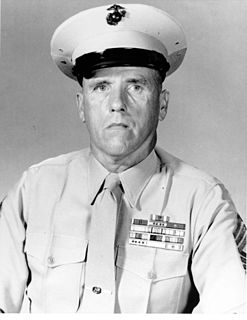
Thomas J. McHugh was a United States Marine who served as the 3rd Sergeant Major of the Marine Corps from June 29, 1962, to July 16, 1965.
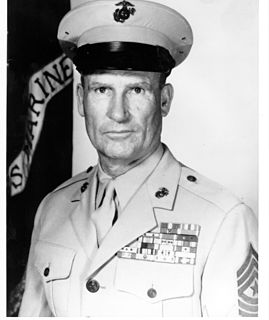
Joseph W. Dailey was a United States Marine who served as the 5th Sergeant Major of the Marine Corps from 1 August 1969 until he retired from active duty on 31 January 1973. Dailey was the oldest living former Sergeant Major of the Marine Corps when he died in 2007. Dailey served in combat in three wars—World War II, the Korean War, and the Vietnam War—earning the Silver Star for actions during the Battle of Okinawa and the Navy Cross and the Bronze Star Medal for heroism in Korean. He was a member of The Church of Jesus Christ of Latter-day Saints.

Lewis G. Lee is a retired United States Marine who served as the 13th Sergeant Major of the Marine Corps from 1995 to 1999. He retired from active duty in 1999 after over 31 years of service.

Harold G. Overstreet is a retired United States Marine who served as the 12th Sergeant Major of the Marine Corps from 1991 to 1995.
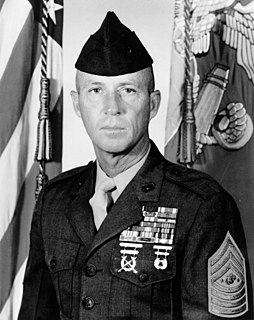
David W. Sommers is a retired United States Marine who served as the 11th Sergeant Major of the Marine Corps from 1987 to 1991.

Jimmie Earl Howard was a Marine Corps staff sergeant when he led an eighteen-man reconnaissance patrol in a fierce battle against a battalion of Viet Cong in June 1966. As a result of his heroic actions, Howard became the sixth U.S. Marine to be awarded the nation's highest honor for heroism in combat in Vietnam. The Medal of Honor was presented by President Lyndon B. Johnson in White House ceremonies on August 21, 1967.
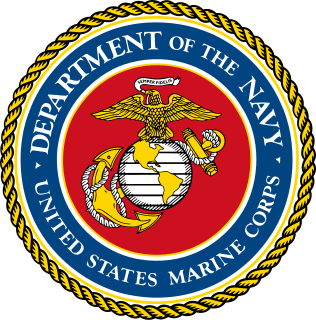
The United States Marine Corps is organized within the Department of the Navy, which is led by the Secretary of the Navy (SECNAV). The most senior Marine commissioned officer is the Commandant of the Marine Corps, responsible for organizing, recruiting, training, and equipping the Marine Corps so that it is ready for operation under the command of the unified combatant commanders. The Marine Corps is organized into four principal subdivisions: Headquarters Marine Corps, the Operating Forces, the Supporting Establishment, and the Marine Forces Reserve.

Edgar R. Huff was the first African-American in the United States Marine Corps to be promoted to the rank of sergeant major. He served in World War II, the Korean War and the Vietnam War.
In the United States Marine Corps, the ground combat element (GCE) is the land force of a Marine Air-Ground Task Force (MAGTF). It provides power projection and force for the MAGTF.

Major General Ronald G. Richard is a retired United States Marine Corps officer who last served as the Commanding General of Marine Corps Base Camp Lejeune.
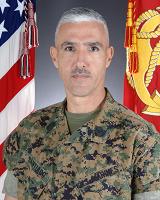
Sergeant Major Jose Luis Santiago is a retired member of the United States Marine Corps who has the distinction of being the 2nd Battalion, 9th Marines' first Hispanic Sergeant Major and its first Sergeant Major since its reactivation on July 13, 2007. Was assigned to the Marine Corps Recruiting Command Recruiting Station Jacksonville, 6th Marine Corps District

Justin D. LeHew is a United States Marine serving in the War on Terror. He was awarded the Navy Cross for his actions on 23 and 24 March 2003 during the initial 2003 invasion of Iraq. He was hand picked to spearhead the rescue operation and recovery of the U.S. Army's 507th Maintenance Company on 23 March and subsequently was called upon again to take part in the rescue operation of US Army Private Jessica Lynch on 1 April 2003. He is also a recipient of the Bronze Star W/V for his heroic actions from 5 to August 28, 2004 during the Battle of Najaf.

A special amphibious reconnaissance corpsman (SARC) is a United States Navy hospital corpsman who provides the Marine Special Operations reconnaissance teams and other USSOCOM units advanced trauma management associated with combatant diving and parachute entry. Traditionally, they are attached to the Marine Corps Force Reconnaissance companies to help support the Command Element of the Marine Air-Ground Task Force in special reconnaissance missions.

The United States Marine Corps Reconnaissance Training Company trains Marines in the amphibious environment as a Reconnaissance Marine, MOS 0321. It is under the Advanced Infantry Training Battalion (AITB) of the School of Infantry (West), Marine Corps Base Camp Pendleton, California.

Micheal P. "Mike" Barrett is a retired United States Marine who served as the 17th Sergeant Major of the Marine Corps, succeeding Carlton W. Kent on June 9, 2011. As the Sergeant Major of the Marine Corps, Barrett was the highest ranking noncommissioned officer in the United States Marine Corps. He was succeeded by Ronald L. Green on February 20, 2015.
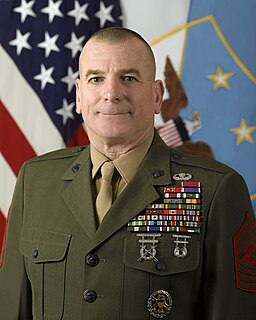
Bryan B. Battaglia is a retired United States Marine who served as Senior Enlisted Advisor to the Chairman of the Joint Chiefs of Staff, sworn into office on 30 September 2011. He held this position until December 11, 2015.


























